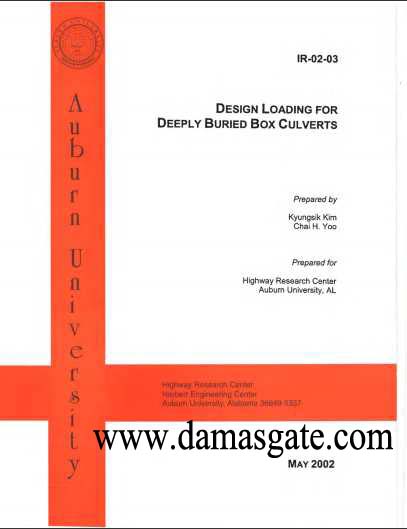Design Loading for Deeply Buried Box Culverts

Design Loading for Deeply Buried Box Culverts
Kyungsik Kim
and
Chai H. Yoo
Highway Research Center Auburn University
Auburn University, Alabama
May 2002
Acknowledgments
The investigation which led to the results presented herein was supported jointly by the Huff Eminent Scholar fund and the Highway Research Center at Auburn University. The authors gratefully acknowledge the assistance provided by D. L. Allen of Kentucky Transportation Research Center including the source code of PC version ISBILD.
Disclaimer
The opinions and conclusions expressed or implied in the report are those of the authors. They are not necessarily those of the funding agencies.
1.1 Statement of the Problem
INTRODUCTION
Cast-in-place or precast reinforced concrete box culverts are widely used throughout the
world to provide safe and relatively economical structures for the conveyance of water, vehicles,
utilities or pedestrians. Although the single cell or multi-cell box culverts are rather simple
structures, the loadings applied to these structures during their construction and subsequent
service life can be complex. These structures are subjected to substantial vertical and lateral
earth pressures, and are often SUbjected to significant temporary loadings during the construction
of the embankment. In spite of the complex nature of the loading around these structures, simple
routine design procedures would be highly desirable if they could be made possible.
When the relative settlement of the soil prism directly above the structure is greater than
that of the adjacent soil prisms, as in trench installations, the layers of soil in the central prism
are subjected to a reverse arch shape defonnation and consequently the earth pressure on the
structure is reduced by the amount of the shearing forces exerted to the central soil prism.
Likewise, when the relative settlement of the soil prism directly above the structure is less than
that of the adjacent soil prisms, as is usually found in embankment installations, the layers of soil
on the central prism are subjected to an arch shape defonnation and the earth pressure on the
structure is increased. Although Marston[I,2] and Spangler[3,31,32] successfully quantified these
phenomena by solving differential equations based on the equilibrium conditions of a simplified
free body of prisms, an opportunity exists to revisit the problem using the modern-day numerical
techniques made possible by the development of finite element methods.
Download
http://s18.alxa.net/s18/srvs2/01/Des...x.Culverts.rar
